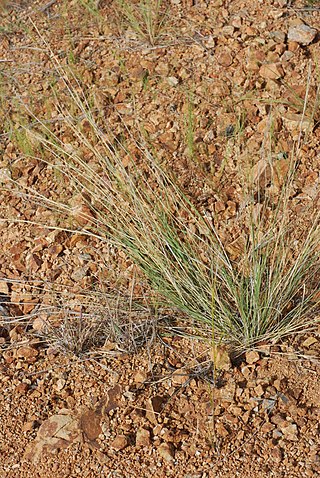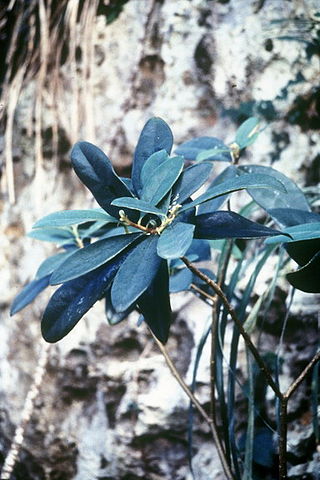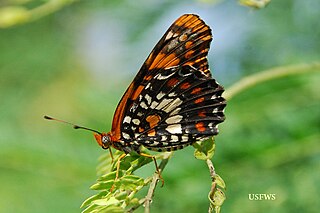
Calyptronoma rivalis is a pinnately compound leaved palm species that is native to the Caribbean islands of Hispaniola and Puerto Rico. Its common names include palma de manaca and Puerto Rican manac.
Auerodendron pauciflorum is a rare species of flowering plant in the family Rhamnaceae. One English language common name is turtlefat. It is endemic to Puerto Rico, where it is known from only one population in Isabela. At the time the plant was federally listed as an endangered species by the United States in 1994, only ten individual plants were known to exist. By 1997, there were 19 known specimens.

Buxus vahlii, or Vahl's boxwood, is a rare species of plant in the boxwood family. It is native to Puerto Rico and St. Croix in the U.S. Virgin Islands, where it is known from no more than four populations in total. It has probably never been very common, but its distribution has been reduced by deforestation and other human disturbance of its habitat. At the time it was listed as an endangered species of the United States in 1985, it was thought to be endemic to Puerto Rico. Reports that it existed in Jamaica have not been confirmed. A few individuals have been located in St. Croix, some of which are within Sandy Point National Wildlife Refuge.

Eugenia woodburyana is a species of plant in the family Myrtaceae. It is endemic to Puerto Rico. It is a federally listed endangered species of the United States. It is threatened by habitat loss.
Adiantum vivesii is a rare species of maidenhair fern known by the common name Puerto Rico maidenhair.

Aristida chaseae is a rare species of grass known by the common name Chase's threeawn. It is endemic to Puerto Rico, where it is known from two locations in the Cabo Rojo National Wildlife Refuge and the Sierra Bermeja. It is a federally listed endangered species of the United States. It cannot compete with introduced species of grasses, such as Brachiaria subquadripara, which are invading its habitat.

Cornutia obovata is a rare species of tree in the mint family, and formerly considered a member of the verbena family. It is endemic to forested slopes in Puerto Rico, where its common names are capá jigüerilla, nigua, and palo de nigua. When it was added to the endangered species list of the United States in 1988 there were only seven individuals known to remain in the wild. By 1998 there were eight plants known. This is considered one population divided amongst a few locations in the mountain forests of the island.
Cranichis ricartii is a rare species of orchid known by the common name Puerto Rico helmet orchid. It is native to Puerto Rico, where it is known from three locations in one forest. The plant has also been seen in Guadeloupe. The plant's rarity is the main reason for its listing as an endangered species of the United States.

Daphnopsis helleriana is a rare species of flowering plant in the genus Daphnopsis of the family Thymelaeaceae. It is endemic to Puerto Rico, where there were only four populations remaining in 1992, with a total of 125 individuals. It was federally listed as an endangered species of the United States in 1988.
Elaphoglossum serpens is a rare species of fern that grows only on Cerro de Punta, the highest mountain in Puerto Rico. The fern grows at one location, where there are 22 known specimens. It was federally listed as an endangered species of the United States in 1993.

Mitracarpus maxwelliae is a rare species of flowering plant in the coffee family known by the common name Maxwell's girdlepod. It is endemic to Puerto Rico, where it is known only from the Guánica Commonwealth Forest in Guánica. It grows in only one location in a coastal scrub forest and dwarf forest with limestone gravel substrates. Other plants in the habitat include Bucida buceras, Bursera simaruba, Exostema caribaeum, Coccoloba microstachya, Plumeria alba, and Pilosocereus royenii.
Polystichum calderonense is a rare species of fern known by the common name Monte Guilarte hollyfern. It is endemic to Puerto Rico, where it occurs in the Guilarte State Forest. There are only 57 individual plants remaining. It is a federally listed endangered species of the United States.
Amauropelta inabonensis, synonym Thelypteris inabonensis, is a rare species of fern known by the common name cordillera maiden fern. It is endemic to Puerto Rico, where it is known from only two localities: at the headwaters of Río Inabón and at the Toro Negro State Forest. It is a federally listed endangered species of the United States.
Goniopteris verecunda, synonym Thelypteris verecunda, is a rare species of fern known by the common name Barrio Charcas maiden fern. It is endemic to Puerto Rico, where it is known from only three localities. It is a federally listed endangered species of the United States.

Goniopteris yaucoensis, synonym Thelypteris yaucoensis, is a rare species of fern known by the common name Puerto Rico maiden fern. It is endemic to Puerto Rico, where it is known from only three localities. It is a federally listed endangered species of the United States.

Vernonia proctorii is a rare species of flowering plant in the aster family known by the common name Proctor's ironweed. It is endemic to Puerto Rico, where there are two populations. It is threatened by the destruction of its habitat. It is a federally listed endangered species of the United States.

Rio Abajo State Forest is a forest preserve in Puerto Rico owned by the Department of Natural Resources and one of the 20 state forests in the island. It was designated a National Natural Landmark in 1980 and constitutes an area of 3,590 acres. It consists mostly of subtropical wet and moist karst forest. Mogotes and sinkholes fill the landscape. The forest preserve is located in the municipalities of Arecibo and Utuado. In addition to its ecological value the forest also contains a number of archaeological sites.

Atlantea tulita is a rare species of butterfly known by the common name Puerto Rico harlequin butterfly. This brush-footed butterfly is endemic to Puerto Rico. It is a candidate for United States federal protection as an endangered species. In 2011 a report found federal protection to be warranted, but it was precluded by other actions and it remains a candidate.

Guilarte State Forest is one of the 20 forests that make up the public forests system in Puerto Rico. The forest is located in the eastern half of the Central Mountain Range or Cordillera Central. The main geographical feature of the forest reserve is Monte Guilarte, which is Puerto Rico's 7th highest mountain at 3,950 feet above sea level. While Monte Guilarte is located in the municipality of Adjuntas, the forest's borders also include parts of Guayanilla, Peñuelas and Yauco.












